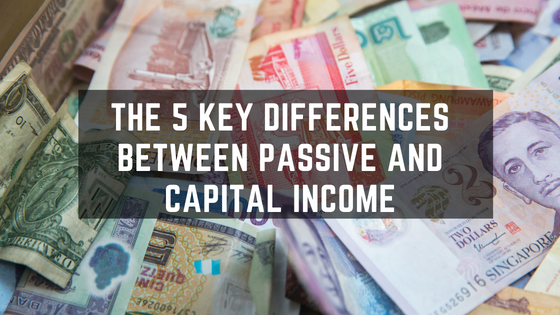There are two types of income: passive and capital. Passive income is money earned from investments, such as dividends from stocks or interest from savings accounts. Capital income is money earned from selling assets, such as property or stocks. So, what are the key differences between these two types of income? Read on to find out.
What is passive income?
Passive income is defined as earnings derived from a rental property, limited partnership, or other enterprises in which a person is not actively involved. The IRS views passive income as money earned with little to no effort on the part of the recipient. To be considered active, taxpayers must demonstrate “materially participating” in their enterprise.
In contrast, capital gains are realized when an investor sells an asset for more than its original purchase price. The IRS taxes capital gains at lower rates than ordinary income, making it a more favorable way to grow your wealth over time.
While both forms of income can be used to grow your financial portfolio, they differ in how they’re taxed and the level of effort required to generate them. As such, it’s important to understand the key differences between passive and capital income before making any investment decisions.
What is capital income?
Capital income is defined as earnings from investments, such as dividends from stocks, interest from bonds, and capital gains from the sale of assets. Passive income, on the other hand, is income that does not require active work to generate. Examples of passive income include rental income from property, royalties from patents or copyrights, and interest from savings accounts.
While both types of income can be used to finance your lifestyle, there are key differences between the two. Capital income is typically more volatile than passive income, meaning it can fluctuate greatly in response to changes in the market. For example, if you have investments in stocks and the stock market crashes, your capital income will likely decline significantly. Passive income, on the other hand, is not as impacted by market fluctuations since it does not come directly from investments.
Another key difference is that capital income typically requires more effort to generate than passive income. For example, if you want to earn interest from a savings account, you must actively deposit money into the account and monitor it regularly to make sure your balance remains above a certain amount (known as the minimum balance). With passive income sources like rental property or royalties, you can set up the initial investment and then let it generate earnings with minimal ongoing effort required on your part.
Finally, it’s important to remember that both types ofincome can be taxed by the government. Capital gains taxes apply to profits made from selling investments, while passive incomes like rental earnings may be subject
The 5 key differences between passive and capital income
There are a few key differences between passive and capital income that you should be aware of. Here are 5 of the most important ones:
1. Passive income is generally earned without any active involvement from the person generating it. Capital income, on the other hand, usually requires some level of active involvement in order to generate it.
2. Passive income is typically generated from sources that require little to no maintenance or upkeep, such as rental properties or dividends from investments. Capital income, on the other hand, often comes from assets that need to be actively managed in order to generate returns, such as a business or a portfolio of stocks and bonds.
3. Passive income tends to be more stable and predictable than capital income. This is because it doesn’t usually fluctuate based on the performance of the underlying asset. For example, if you own a rental property, your monthly rental payments will likely stay relatively consistent even if the value of the property goes up or down.
4. Passive income can often be generated without much upfront investment, whereas capital income typically requires a significant amount of money to get started.
5. Finally, passive income is often taxed at lower rates than capital gains from selling assets such as stocks or real estate.
Which one is better?
There are a few key differences between passive and capital income that you should be aware of before making any decisions. For one, passive income is generally considered to be much more stable than capital income. This is because it typically comes from sources that are not subject to market fluctuations, such as rental properties or royalties from patents.
Another key difference is that passive income is usually taxed at a lower rate than capital income. This is because it is considered to be a long-term investment, rather than simply unearned income. Finally, passive income can often be generated without any upfront investment, whereas capital income usually requires some amount of initial investment.
How to generate passive income
There are a few key things to remember when it comes to generating passive income. First, it’s important to have a plan and be organized. Without a plan, it’s easy to get sidetracked or lost along the way. Second, focus on creating multiple streams of income. This way, if one stream dries up, you have others to keep you afloat. Finally, don’t forget to diversify your income sources. This will help protect you from financial hardships in the future.
If you’re interested in generating passive income, there are a few options available to you. One popular method is through real estate investing. You can purchase property and rent it out to generate income each month. Another option is to invest in stocks or mutual funds that pay dividends. These can provide you with regular payments, which can serve as passive income over time. Finally, you could also consider starting your own business; while this will require more work upfront, it could provide you with consistent passive income in the long run.
Whatever method you choose, remember that it takes time and effort to generate passive income. However, if you’re patient and persistent, you can eventually achieve financial freedom.
Conclusion
There are a few key differences between passive and capital income, which include the amount of effort required to generate the income, the Stability of the income, and the Taxability of the income. Passive income is generally considered to be more desirable because it requires less effort to generate and is often more stable than capital income. However, capital gains are often taxed at a lower rate than other forms of income, making them an attractive option for those looking to minimize their tax liability.



